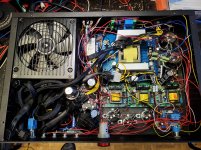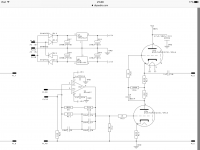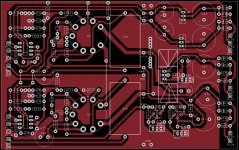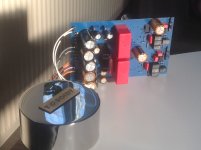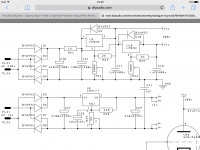Hi Eli,
You're absolutely correct, of course. Either a 6DJ8/ECC88/6922 cascode or a good pentode would greatly reduce Cin (due to Miller effect).
I bought a sleeve of 6AC7 from the late lamented ESRC a few years ago. Would be fun to experiment with those. But is that type really a good choice for the input stage of a phono preamp? Metal can, octal base and all?
12AX7/ECC83 with unbypassed Rk as the 2nd stage looks like it should work with extremely low THD as long as it's (lightly) loaded by a follower.
6DJ8-cascode to 12AX7 (unbypassed Rk) to cathode or source follower would be a really good topology, I think. BUT... that solution requires a more complex power supply, since the cascode or pentode will have poor PSRR, right where it hurts—at the input stage where signal levels are lowest.
The op-amp has very high PSRR and only requires a +/-12V DC supply delivering 16mA or so. It also does not need a heater supply. That's just too cheap, easy and high performing to ignore. Then the triodes run at higher signal levels so the power supply has to be merely 'good' instead of 'damn near noiseless'.
Now, whether or not I'll enjoy the sound from it is another story. I do like that 'tube sound'...
--
You're absolutely correct, of course. Either a 6DJ8/ECC88/6922 cascode or a good pentode would greatly reduce Cin (due to Miller effect).
I bought a sleeve of 6AC7 from the late lamented ESRC a few years ago. Would be fun to experiment with those. But is that type really a good choice for the input stage of a phono preamp? Metal can, octal base and all?
12AX7/ECC83 with unbypassed Rk as the 2nd stage looks like it should work with extremely low THD as long as it's (lightly) loaded by a follower.
6DJ8-cascode to 12AX7 (unbypassed Rk) to cathode or source follower would be a really good topology, I think. BUT... that solution requires a more complex power supply, since the cascode or pentode will have poor PSRR, right where it hurts—at the input stage where signal levels are lowest.
The op-amp has very high PSRR and only requires a +/-12V DC supply delivering 16mA or so. It also does not need a heater supply. That's just too cheap, easy and high performing to ignore. Then the triodes run at higher signal levels so the power supply has to be merely 'good' instead of 'damn near noiseless'.
Now, whether or not I'll enjoy the sound from it is another story. I do like that 'tube sound'...
--
Idea 1 is basically a simplified Aikido Phono Stage, no? The active load ('half-mu') stage has half the gain of a common cathode amp, which would probably push me to put a 12AX7 or 6N2P for the first two stages.
The second one is interesting. However, in a phono stage, don't you want as much clean gain as possible up front in the first stage, to reduce noise? Interesting idea to use 6BQ7 as the input tube...
The third one is basically the same as the Bugle, but using a different opamp (I'm using OPA2134s). It's pretty good, actually.
Idea one is an Aikido without the Aikido... So I just call it active loading.
The second one I designed as an alternative to using 6N6P or the like to drive low Z Hi C load/cable.
The third one should be interesting. I want to modify it to use a single 9V supply. Battery RIAA 🙂
The actual design I use is the first, but I use 6N1, 6N3, 6N2, 6N3 for it. Same parts though. Powered by a 12V SMPS for the heaters that also powers a DC-DC boost bodule to make 280V for the B+. No noise/hum is disearnable with headphones so I call it plenty good clean enough.
Hey kodabmx,
For me, the power supply is the hurdle I need to get over. I have a couple of 12V smps to throw at a phono preamp project. I have a Heathkit HV bench supply I've just recapped and replaced its rectifier diodes, but it still doesn't work. (Gnashing of teeth...)
I ordered an Aikido Phono Stage from GlassWare. I figure that will be fun to play with.
When I built my Hagerman Bugle (first version, with OPA2134 op-amps) I had it working with 9V batteries. It worked fine that way. I later ordered Hagerman's +/-15VDC psu, which I think sounds pretty much the same. Maybe the higher voltage supply makes the preamp sound a tiny bit better. I just didn't like the idea of running the preamp with failing batteries.
Hagerman Bugle (original version) - http://www.hagtech.com/pdf/bugle.pdf
--
For me, the power supply is the hurdle I need to get over. I have a couple of 12V smps to throw at a phono preamp project. I have a Heathkit HV bench supply I've just recapped and replaced its rectifier diodes, but it still doesn't work. (Gnashing of teeth...)
I ordered an Aikido Phono Stage from GlassWare. I figure that will be fun to play with.
When I built my Hagerman Bugle (first version, with OPA2134 op-amps) I had it working with 9V batteries. It worked fine that way. I later ordered Hagerman's +/-15VDC psu, which I think sounds pretty much the same. Maybe the higher voltage supply makes the preamp sound a tiny bit better. I just didn't like the idea of running the preamp with failing batteries.
Hagerman Bugle (original version) - http://www.hagtech.com/pdf/bugle.pdf
--
Here is the quick and easy solution that I use. DC-AC Converter 12V to 110V 200V 220V 280V 150W Inverter Boost Board Transformer | eBay
Here's a pic of one with it's friends in the PSU I built for the main integrated amp.
A little bit messy, but it works.
Here's a pic of one with it's friends in the PSU I built for the main integrated amp.
A little bit messy, but it works.
Attachments
Last edited:
Can you run both the heaters and the B+ from a single 12VDC smps?
Or do you need two 12VDC supplies, one for the heaters and the other to feed the boost converter?
--
Or do you need two 12VDC supplies, one for the heaters and the other to feed the boost converter?
--
I run all heaters from the same 12V that powers the DC boost. I don't elevate the heaters (close enough to spec not to care) though. If you require elevated heaters, you'd need two 12V supplies.
Is it necessary to compensate for that? If so, what's the commonly accepted way to do that?
Some add a compensating pole elsewhere in the circuit. Just before the cathode follower
may be the best place for it in this circuit, or else where you have C4 in the schematic.
Last edited:
Koifarm, where did you find this hybrid prono pre? Is the PCB for sale somewhere?
Regards, Gerrit
Regards, Gerrit
Hello Gerrit,
it is my own design and part of the sound and comfort preamp also here on diyaudio.
You can use the mm phone preamp also standalone as i did i my preamp.
The PCB i made myself but in the thread i can publisch the gerber files so you can order the PCB yourself.
it is my own design and part of the sound and comfort preamp also here on diyaudio.
You can use the mm phone preamp also standalone as i did i my preamp.
The PCB i made myself but in the thread i can publisch the gerber files so you can order the PCB yourself.
Hey Koifarm, nice one!
So you had the op-amp do all the RIAA EQ in its feedback loop, and the 2C51 mu-follower for the output stage.
Why 2C51 (or 6N3P or 5670)? Any special reason? Would an ECC88 or 6DJ8 work as well?
--
So you had the op-amp do all the RIAA EQ in its feedback loop, and the 2C51 mu-follower for the output stage.
Why 2C51 (or 6N3P or 5670)? Any special reason? Would an ECC88 or 6DJ8 work as well?
--
I bought a sleeve of 6AC7 from the late lamented ESRC a few years ago. Would be fun to experiment with those. But is that type really a good choice for the input stage of a phono preamp? Metal can, octal base and all?
The "classic" RCA phono preamp has been executed many times, with 6SL7s. Just use mica loaded phenolic sockets that damp out some vibration. Metal envelope tubes can be microphonic. Prophylaxis for that includes a silicone rubber "O" ring, where the base meets the envelope and a dollop of high temperature RTV silicone on the top of the envelope.
Pentode partition noise is a "bogeyman" for phono stage 1st gain blocks. It's there and that's that. However, high gm reduces net noise and the gm of the 6AC7 is a hefty 9 mA./V. 0A2 regulate g2 B+, for max. linearity. DC heating is mandatory.
A 6AC7 MM phono preamp has been on my RADAR, for some time. I'll gladly support any effort folks make to give that a go. Multi-generational COVID financial stress has all projects here on hold. 🙁 Survival for 3 generations takes priority over hobbies.
Or ditch the tubes entirely and go with the third one......The third one is basically the same as the Bugle, but using a different opamp (I'm using OPA2134s). It's pretty good, actually.
The third schematic looked familiar, so I looked in my computer and it is. I built one of these right into the base of by old 1980 vintage Technics direct drive TT over 10 years ago. The schematic comes from the front page of the National Semiconductor (before TI) LME49720 data sheet.
Since there is no cable between the arm and the PC board I put a larger than 10 pF cap at the input. If I remember right there are two sets of caps and a jumper plug to accommodate two different carts.
I haven't opened the TT up in several years, so I may not remember if that's true. I did make two or three different boards. One was tiny enough to fit inside the headshell, but that idea didn't work out. Power must be muxed with signal since there are only 4 wires in the arm......I never got it working right.
I bought a sleeve of 6AC7....But is that type really a good choice for the input stage of a phono preamp?
I'm using them as the input stage in a high gain guitar amp, where they work good.
Last edited:
Hey Koifarm, nice one!
So you had the op-amp do all the RIAA EQ in its feedback loop, and the 2C51 mu-follower for the output stage.
Why 2C51 (or 6N3P or 5670)? Any special reason? Would an ECC88 or 6DJ8 work as well?
--
Hello,
bendix 2C51 is just my favourit preamp tube. I use it in the outputstage of my shanling cd T100se CD player , MHZS CD33 cd player, phonodude mm preamp and the sound and comfort preamp.
But shure you can use ecc88. Amplication changes from 40 to 100 times, so the opamp needs to amplicate less.( change R28 to 4k7). Maybe you must change the resistors of the tubestage to get the right setting.
PL38 is the phono input without impedance loading, you must ad resistor and capacitor according to your cartridge. And you can use several other opamps. At the moment i use AD847 but you can also try OPA134 or NE5534.
The TPS regulator boards can be changed for lm317/337 or lm7815/7915 for lower cost.
Hello Rongon,
i have not the intention to hijack your thread. So i have made a new thread for discussions about my schematic. look here: https://www.diyaudio.com/forums/analogue-source/362868-hybrid-phono-preamp.html#post6407541
If necessary i shall answer your questions also here.
Ronny
i have not the intention to hijack your thread. So i have made a new thread for discussions about my schematic. look here: https://www.diyaudio.com/forums/analogue-source/362868-hybrid-phono-preamp.html#post6407541
If necessary i shall answer your questions also here.
Ronny
Most interconnects have 200 or more pF already. Miller capacitance of a tube input might be 30pF or so. Not all that much.
Right, capacitor at input is often not necessary. It depends on your cartridge. By tweaking the input resistance( norm 47k) between 47and 100k you can rise the hights a little.
I measured the capacitance of a few of my tonearm cables and got about 150pF for the one I'm using at the moment, 100pF for a shorter one, and 200pF for a longer one. That's enough load capacitance right there, if you ask me.
If you're using a tube input stage, added capacitance at the input will be detrimental.
C input for a triode is Cin = Cgk + Cgp*(A+1)
For a medium-mu triode like 6SN7 this is going to be pretty low since A+1 will be <18.
But for a high-mu triode such as 12AX7 (ECC83) like you'll see in many tube phono stages, this can be pretty high. For 12AX7 A+1 will be anywhere from 50 to 70.
From What is Miller Capacitance?
For example, a typical 12AX7 stage has the following capacitances and gain:
Cgk = 1.6pF + 0.7pF stray = 2.3pF
Cgp = 1.7pF + 0.7pF stray = 2.4pF
A = 61
Therefore, the total input capacitance would be:
Cin = 2.3pF + (61+1)* 2.4pF = 151.1pF
Add 150pF cable capacitance from the tonearm and interconnect and you have 300pF load on the cartridge.
___________________________
Using a 6DJ8 (ECC88) Cin will be roughly:
Cin = Cgk + Cgp*(A+1)
Cgk = 1.5pF + 0.7pF strays = 2.2pF
Cga = 1.4pF + 0.7pF strays = 2.1pF
A = 25 (more or less)
2.4pF + 2.1pF(26) = 57pF
With a 6DJ8 first stage, add 150pF of cable capacitance and you have about 200pF load on the cartridge.
--
If you're using a tube input stage, added capacitance at the input will be detrimental.
C input for a triode is Cin = Cgk + Cgp*(A+1)
For a medium-mu triode like 6SN7 this is going to be pretty low since A+1 will be <18.
But for a high-mu triode such as 12AX7 (ECC83) like you'll see in many tube phono stages, this can be pretty high. For 12AX7 A+1 will be anywhere from 50 to 70.
From What is Miller Capacitance?
For example, a typical 12AX7 stage has the following capacitances and gain:
Cgk = 1.6pF + 0.7pF stray = 2.3pF
Cgp = 1.7pF + 0.7pF stray = 2.4pF
A = 61
Therefore, the total input capacitance would be:
Cin = 2.3pF + (61+1)* 2.4pF = 151.1pF
Add 150pF cable capacitance from the tonearm and interconnect and you have 300pF load on the cartridge.
___________________________
Using a 6DJ8 (ECC88) Cin will be roughly:
Cin = Cgk + Cgp*(A+1)
Cgk = 1.5pF + 0.7pF strays = 2.2pF
Cga = 1.4pF + 0.7pF strays = 2.1pF
A = 25 (more or less)
2.4pF + 2.1pF(26) = 57pF
With a 6DJ8 first stage, add 150pF of cable capacitance and you have about 200pF load on the cartridge.
--
Last edited:
Incidentally, Morgan Jones in his book Valve Amplifiers 4th Edition measured the interelectrode capacitances of a few valves and found that they had higher capacitance in real life than shown in the data sheets. That means the capacitances shown in the previous post may be lower than in reality. A 12AX7 could have as high as 200pF input C in a real-life circuit. That and the interconnect cable could put a 350pF load on the cartridge.
--
--
- Home
- Amplifiers
- Tubes / Valves
- Possibly silly idea - Opamp input-Triode w/ Cathode Follower Output RIAA Phono Stage
